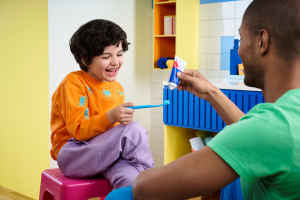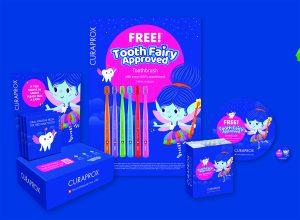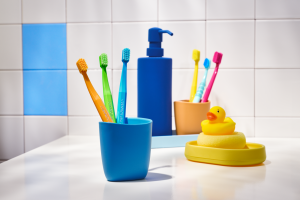
In the animated classic Finding Nemo, the titular character is imprisoned in a dentist’s fish tank, leading to an intense escape during a child’s check-up appointment. The result is a traumatising experience for the young patient, Darla, that taps into the fears that other children may have when visiting the dental practice.
Helping nervous paediatric patients overcome these fears and reduce their anxieties is essential to improve their interest and compliance with maintaining their oral health. Approaches for treating uncooperative children like sedation and physical restraint may work in the moment, but they fail to make the dental practice a place that children can feel safe and happy in. As such, an element of fun may be needed to entertain paediatric patients, with the hope that it leads to greater engagement with their oral health.
Design of the practice
From a young age, children need to perceive the dental practice as a welcoming space. However, those who have had a negative experience elsewhere with medical care, such as in a hospital, may carry a nervousness towards a dental practice, leading to unruly behaviour and an uncooperative dental patient.[i] It has also been noted that a growing number of children lack the abilities and self-control to handle new situations like visiting the dental practice, presenting difficulties for the dental team.i
The visual design of the reception and waiting area can create a positive first impression. The overall attractiveness of a dental practice’s physical environment is significantly associated with higher perceived quality and satisfaction, a reduction in patient anxiety, and more positive interactions between the patient and members of the dental team.[ii] A welcoming atmosphere, as dictated by the colours, layout and lighting of a dental practice, is therefore beneficial to all inside it.
A survey found that children expressed a preference for natural light and decorated walls in the dental practice.[iii] Popular forms of visual entertainment in the waiting area included a TV and an aquarium, though the latter may be a time-consuming expense. It’s also important to not homogenise the tastes of paediatric patients: children aged 6-8 showed more enthusiasm for walls which featured cartoon designs, whereas those aged 9-11 preferred bare walls.ii Colour is still essential though; yellow walls generate a positive, happy emotional state and blue a calmer, more comforting atmosphere.ii
Pleasant to play in
Playing is a vital part of childhood and growth, and a dental appointment should not fully inhibit the opportunity to do so, especially as some children find dental practices intimidating. A designated play area can create a sense of security for young children and serves as a distraction for anxious patients.
There are many options when designing a fun play area. Themed ones, like jungle, space or fairy-tale, create consistency and add a level of escapism to the waiting area. Elsewhere, low tables and chairs with rounded edges, beanbags and cushions are safe alternatives to sit on, reducing the risk of an injury. For forms of entertainment, pens and paper, puzzles, and action figures are all great – though these will need wiping down to prevent the spread of germs. Whereas a generation might remember the abacus as a waiting room stalwart, some dental practices may prefer the ease of tablets, upon which children can play games (these are also quicker to sanitiser after use), or a TV for cartoons.

The fun continues at home
Reducing anxiety and increasing the engagement of paediatric patients can lead to superior oral health outcomes but it also has an economic benefit: shorter treatment times, quicker recovery times and less of a reliance on sedation allows dental practitioners to see more patients.[iv] As such, making dental care fun should also continue at home.

To empower children with looking after their oral health, the Tooth Fairy Gift Set from Curaprox is filled with useful features. Along with the reliable Curaprox Kids Toothbrush and Kids Watermelon Toothpaste, it contains a tooth pouch and a hanging sign for the Tooth Fairy, a tooth loss chart and a guide to cleaning the oral cavity. This improves a child’s understanding of the importance of daily dental care and helps reduce anxieties around dental appointments.

When it comes to managing anxious young children in the dental practice, harbouring a welcoming atmosphere and a well-maintained play area can change the perception of going to the dentist, creating a space that all can feel safe in.
To arrange a Practice Educational Meeting with your Curaden Development Manager please email us on sales@curaden.co.uk
For more information, please visit www.curaprox.co.uk and www.curaden.co.uk
[i] None Jasleen Kaur, None Navjot Kaur, None Heena Walia, None Gauri Gill, Chinemeze, N. and None Rhythm Sharma (2024). Behaviour Management of Children in a Dental Clinic. International Healthcare Research Journal, 7(12), pp.RV1–RV6. doi:https://doi.org/10.26440/ihrj/0712.03617.
[ii] Jayakaran, T., Rekha, Cv., Annamalai, S., Baghkomeh, P. and Sharmin, Dd. (2017). Preferences and choices of a child concerning the environment in a pediatric dental operatory. Dental Research Journal, 14(3), p.183. doi:https://doi.org/10.4103/1735-3327.208767.
[iii] Panda, A., Garg, I. and Shah, M. (2014). Children’s preferences concerning ambiance of dental waiting rooms. European Archives of Paediatric Dentistry, 16(1), pp.27–33. doi:https://doi.org/10.1007/s40368-014-0142-z.
[iv] England, N. (2025). NHS England» Play well: guidelines for commissioning and designing health play services. [online] England.nhs.uk. Available at: https://www.england.nhs.uk/long-read/play-well-guidelines-for-commissioning-and-designing-health-play-services/.




